What are B7-33 peptides?
Peptides B7-33 is a functional selective Relaxin-receptor 1 agonist in development, derived from the naturally occurring human hormone Relaxin-2.
Relaxin’s peptides are structurally similar to insulin-like peptides in that they consist of two chains of 53 amino acids, chain A and chain B, and connect the two chains by three disulfide bonds to function. This chemical structure makes it difficult to recombine or chemically synthesize, so the researchers determined its minimum active structure on the basis of Relaxin and developed a single B-chain peptide analogue B7-33.
The name B7-33 derives from the fact that it contains these 27 residues between 7-33 in the B-chain amino acids in Relaxin, hence the name B7-33.
Use of B7-33 peptides
B7-33 is the smallest active structure in Relaxin-2 and has similar effects to Relaxin, such as vascular dilation, increased renal blood flow, increased pumping volume in patients with acute heart failure without increasing cardiac burden, rapid anti-inflammatory, anti-hypertrophy, anti-fibrosis, etc. In the treatment of myocardial infarction, B7-33 induces a link between mitogen-activated protein kinase signaling and the heart’s unfolded protein response after infarction, which has a protective effect against ischemia-reperfusion injury after myocardial infarction and promotes pro-inflammatory changes in the tissue during the early stages of infarct healing. B7-33 is also expected to be used in the production of anti-fibrotic materials or materials that resist foreign body reactions.
What is Relaxin?
Relaxin, also known as H2 Relaxin or Relaxin-2, is a peptide hormone that exerts pleiotropic effects in multiple organ systems. Produced primarily in pregnant mammals, it mediates vasodilation (blood vessel dilation) by increasing the production of nitric oxide, causes vasodilation through an indirect mechanism, and inhibits the potent vasodilators angiotensin II and endothelin.
In addition to vasodilation, Relaxin may also affect the kidneys by significantly increasing creatinine clearance as well as increasing renal blood flow. Relaxin also acts as a cardiac stimulant and increase the calcium sensitivity of myocardial filaments and increase the phosphorylation of myofilaments by protein kinase C(PKC). These modifications all work to increase the force produced by the myofilaments without increasing the energy expenditure of the cardiomyocytes. As a result, relaxin and serum relaxin can increase stroke output, the amount of blood pumped out with each heartbeat, without increasing the energy requirements of the already stressed heart in patients with acute heart failure.
Relaxin-2 has been shown to be upregulated in human heart failure patients, suggesting that it may be increased as a compensatory mechanism.
Based on Relaxin’s effects, the researchers developed Serelaxin, a drug for the treatment of acute heart failure.
What is Serelaxin?
Serelaxin is a drug developed by Noval Pharmaceuticals for the treatment of acute heart failure under the development code name RLX030 and the trade name Reasanz. It is a recombinant form of the naturally occurring peptide Relaxin-2 that binds to receptors to activate and up-regulate the production of the endothelin B receptor, vascular endothelial growth factor (VEGF), and nitric oxide (NO). This process results in decreased systemic vascular resistance, increased cardiac output, increased renal blood flow, and increased glomerular filtration rate.
Serelaxin also inhibits angiotensin II and endothelin, thereby causing further systemic and renal vasodilation. Its multifaceted, indirect effects on hemodynamic characteristics, and its minimal side effects, make it an effective drug for the treatment of acute heart failure.
In a Phase III clinical trial, Serelaxin was evaluated for organ protection in patients with acute heart failure. Serelaxin can play a rapid anti-inflammatory, anti-hypertrophy, anti-fibrosis, vasodilation and angiogenesis effect, has the effect of preventing tissue damage, and faster relief of organ congestion after treatment.
B7-33 peptides vs Serelaxin
Sicentists has study Serelaxin for many years, and the results are relatively mature, and it already use to treat acute heart failure. Basi on Serelaxin, they develop the new peptides B7-33 , why peptides B7-33?
Chemical synthesis difficulty and cost control
Serelaxin, A recombination of the naturally occurring peptide hormone Relaxin-2, has the same structure as Relaxin-2, that is, it retains the A and B chains of Relaxin-2 and the disulfide bridge that connects them. Therefore, synthetic Serelaxin is not only difficult to synthesize, but also very expensive to develop.
B7-33 is the shortest effective form of the Relaxin-2 structure, intercepts a total of 27 residues of 7-33 in the Relaxin-2 B chain, has no double chain, no disulfide bridge, is easier to synthesize, and has a higher yield. Therefore, B7-33 has great development value.
Different modes of action have no side effects that might promote tumor development
Relaxin is a homologous ligand of the Relaxin family peptide receptor 1 (RXFP1) that produces a biphasic cAMP signal and activates both the pERK and cAMP pathways in most cells. Serelaxin is a reconstituted form of Relaxin that activates both pERK and cAMP. B7-33 is a truncated Relaxin that preferentially activates the pERK pathway over the cAMP pathway. Because cAMP signaling during the progression of heart failure may lead to harmful consequences, such as promoting tumor development. B7-33, which only has a pERK, has no such concern.
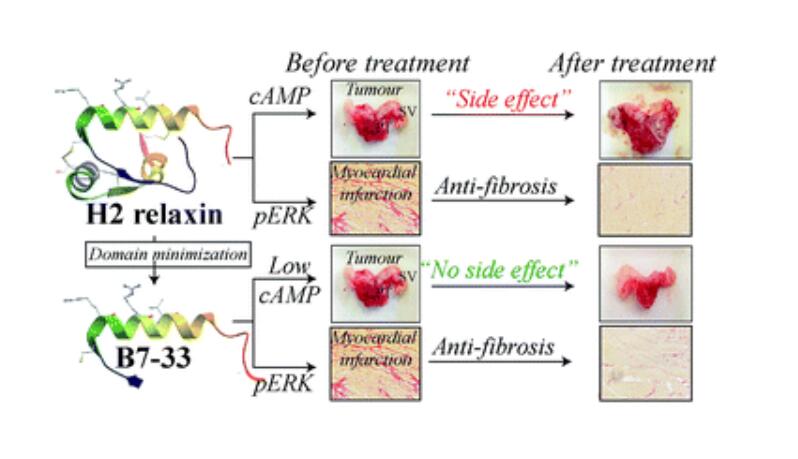
B7-33 peptides benefits in use
Except for the above differences between B7-33 and Serelaxin, its effects are essentially the same as those of Serelaxin or Relaxin.
Treatment of acute heart failure
Acute heart failure, a type of cardiovascular disease, is the most common reason for hospitalization in patients over 65 years of age. It is a sudden, life-threatening disease. The patient’s heart is still beating, but it cannot provide enough oxygen to meet the body’s needs. As a result, with heart failure, your heart function and the amount of blood your heart can pump to the rest of your body suddenly and rapidly decline.
Typical symptoms of acute heart failure include shortness of breath, tiredness, swelling of the feet and legs. Serelaxin is a new drug for acute heart failure, while B7-33 is clearly a newer drug. B7-33 is still being studied, but it shows a better effect than Serelaxin, and it is easier to synthesize and has a higher yield.
Assisted ischemia-reperfusion after myocardial infarction
Myocardial infarction (MI) characterize by the cessation of blood supply to the heart tissue, resulting in damage or death of heart muscle cells in the affected area. Although hospital mortality has significantly reduce due to advances in revascularization techniques, the reintroduction of oxygen triggers a cascade of maladaptations within the ischemic tissue. The resulting pathological injury is called ischemia-reperfusion (IR) injury.
With B7-33, infarct size was reduced, FS was preserved, and radial strain asymmetry 24 hours after myocardial infarction was reduced.
In the trial, treatment with B7-33 resulted in a 21% reduction in infarct size (45% in the saline treatment group). Therefore, B7-33 may be used to alleviate myocardial infarction and prevent adverse cardiac remodeling associated with myocardial infarction.
Antifibrosis
Fibrosis, the regrowth of scarring or disorganized tissue, is the end state of at least half of chronic diseases. From cardiovascular disease to lung disease to cirrhosis, abnormal wound healing (i.e., fibrosis) is one of the leading causes of organ failure. Studies have shown that B7-33 has an immediate vasodilatory effect and reduces the long-term scarring that occurs after heart injury. B7-33 not only does not promote tumor growth during the treatment of fibrosis, it does not promote tumor growth even at higher doses than those that produce antifibrotic effects. Because B7-33 works almost exclusively through the pERK pathway and does not stimulate cAMP.
Cardiovascular diseases and inflammatory lung diseases, such as asthma and chronic obstructive pulmonary disease (COPD), are the leading causes of death worldwide. A central feature of these diseases is fibrosis, so B7-33 is also effective in treating these diseases.
Mediates hemodynamic changes
B7-33 replicates the vascular protective effects of Serelaxin. It mediates vasodilation (blood vessel dilation) by increasing the production of nitric oxide (NO). Through an indirect mechanism, vasodilation is induced and effective vasodilators angiotensin II and endothelin are inhibited.
In addition to vasodilation, B7-33 also affects the kidneys by significantly increasing creatinine clearance as well as increasing renal blood flow.
Studies have shown that B7-33 can increase the sensitivity of myocardial filament to calcium and increase the phosphorylation of muscle filament by protein kinase C. Both modifications increase the capacity of myofilament production without increasing the energy expenditure of cardiomyocytes. Therefore, B7-33 can increase the amount of blood pumped with each heartbeat without increasing the energy requirements of the heart.
Application in antifibrotic materials
B7-33 may become a material for the production of antifibrotic materials or resistant to foreign body reactions. Under normal circumstances, the body’s response to a foreign object is to try to remove it completely. If cannot do this, then the body will begin to isolate the foreign object through fibrosis, isolating it from the body and reducing its ability to cause disease and dysfunction. This is great for fighting pathogens, but it becomes problematic when people want to implant medical devices, such as cardiovascular stents, into the body. In these cases, fibrosis may cause the implant to malfunction or degrade. In some cases, such as heart stents, fibrosis can lead to blocked arteries, reduced blood supply, and eventually a heart attack.
B7-33 provides an ideal coating for implants, and in one study, the release of B7-33 from the device’s coating reduced fibrotic sac thickness by nearly 50% during a 6-week trial.
The development of anti-fibrotic materials and coatings capable of resisting foreign body reactions remains a major obstacle to the development of current and next-generation implantable medical devices, biosensors, and cell therapies. The B7-33 offers an alternative.









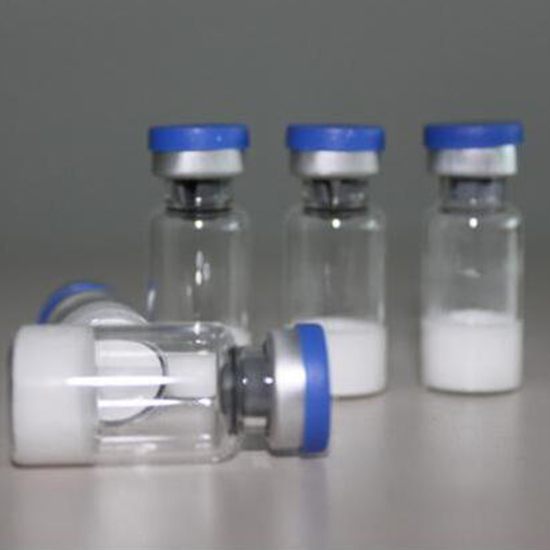
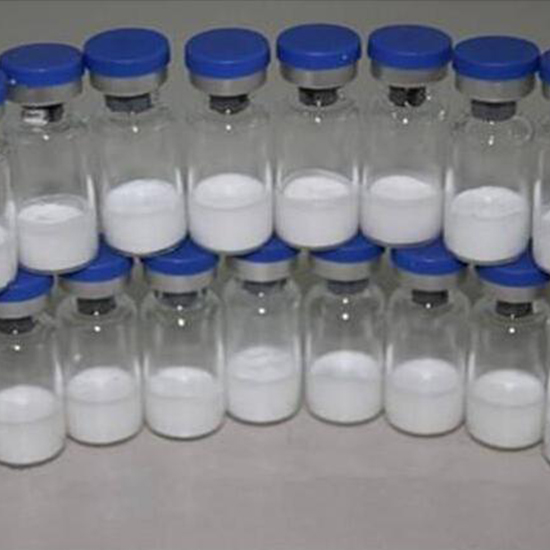
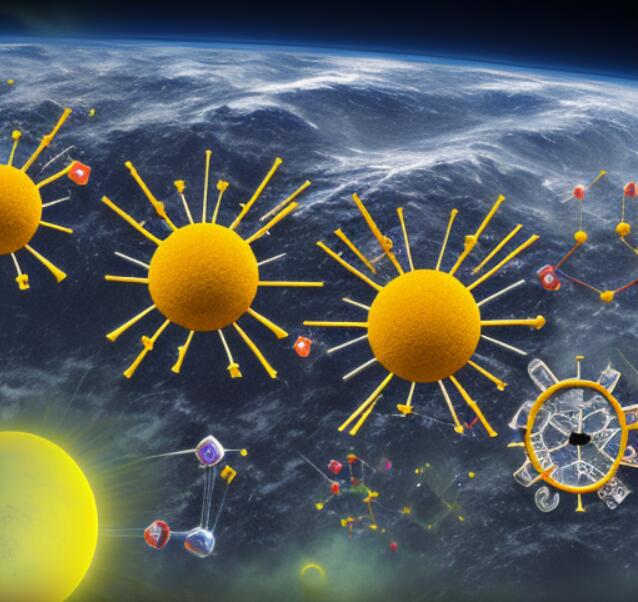
 Retatrutide LY-3437943 benefits in weight loss 17.5% in 24weeks
Retatrutide LY-3437943 benefits in weight loss 17.5% in 24weeks Type 2 Diabetes Treatment Semaglutide 10mg for Healthy Weight Loss
Type 2 Diabetes Treatment Semaglutide 10mg for Healthy Weight Loss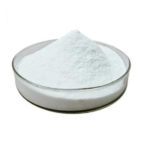 Buy MK-677 powder for sale ibutamoren sarm price bodybuilding mk677 CAS:159752-10-0
Buy MK-677 powder for sale ibutamoren sarm price bodybuilding mk677 CAS:159752-10-0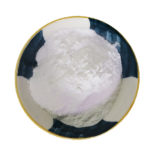 RAD140 stack: 99% Purity Sarms RAD-140 for sale
RAD140 stack: 99% Purity Sarms RAD-140 for sale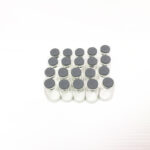 Neuroprotective peptide PE22-28 in mood depression and weight loss
Neuroprotective peptide PE22-28 in mood depression and weight loss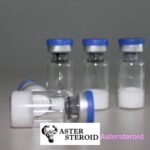 Peptide Alarelin acetate activated GnRH receptors to increase LH and FSH levels
Peptide Alarelin acetate activated GnRH receptors to increase LH and FSH levels FOXO4-DRI anti-aging and increases testosterone levels in men
FOXO4-DRI anti-aging and increases testosterone levels in men Nootropic Adamax vs Semax enhances cognition and post-exercise recovery
Nootropic Adamax vs Semax enhances cognition and post-exercise recovery Peptide Slu-PP-332 Lose weight and promote performance
Peptide Slu-PP-332 Lose weight and promote performance Peptides MOTS-c in bodybuilding and anti-aging use and benefits
Peptides MOTS-c in bodybuilding and anti-aging use and benefits